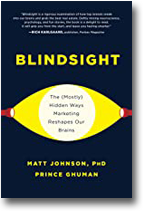Driven by insights from behavioral economics, marketers have begun to cater to the systematic irrationalities of their consumers. This means understanding how consumers actually behave, as opposed to how they should behave.
by Matt Johnson, Phd., and Prince Ghuman
More recently, however, clever marketers also want to go beyond the science of decision making, and instead, tap into the broader field of psychological science. What is this new, more expansive, frontier? What is marketing psychology?
Marketing psychology is the full application of psychological science to marketing and branding. Crucially, marketing psychology picks up where behavioral science leaves off, exploring a much wider realm of psychological perspectives. Decision-making may be a crucial area of psychology for marketers to understand, but it’s only a narrow sliver of what it means to be human. Marketing psychology is about understanding these more general principles and incorporating them into marketing practice.
Let’s examine these key psychological areas.
Marketing Psychology Meets Social Psychology
When you think “social psychology” and “marketing”, you probably instantly think about social media. Of course, social psychology plays a crucial role in technology usage, but its influence doesn’t end there. Humans are deeply social creatures – not just on social media – which means that its influence on our consumer habits is profound.
A consumer’s social identity, for example, has a major impact on the products they buy and the brands they relate to. Jif Peanut Butter taps into this through advertising to mothers by stating “choosy Moms choose Jif”, while Budweiser never lets you forget its strong ties to the “American Identity”. Robinhood anchored its entire brand to the social identity of younger would-be investors who felt shut out from an elitist financial system.
Other brands successfully tap into the social drives to communicate implicitly to their social group. Luxury brands, for example, allow consumers to signal their wealth and status, while sustainable brands come to signify environmental values. More recently, brands such as Nike and Ben & Jerry’s provide the opportunity for consumers to signal their political values.
The better marketers can understand the mechanisms of social psychology, the more opportunities they can uncover for their brand, and the deeper connection they can build with their target market.
Marketing Psychology Meets Evolutionary Psychology
Marketing psychology, like the field of psychology more generally, recognizes the human brain as an organ forged through evolutionary pressures. We’re fish out of water; Modern software running on ancient hardware. The world has changed, but the brain largely hasn’t. Biologically, we’re about the same as our ancient ancestors. It’s our surroundings that have shifted so dramatically.
With this perspective, we can easily see that the human brain is not designed for the modern consumer world. What this means is that the nature of every consumer behavior is relying on neural structures and innate leanings which evolved for very different purposes.
Consider, for example, the phenomenon of the Mere Exposure Effect: The more we’re exposed to something, the more we like it. This is why pop songs tend to grow on us over time, and why Coke, despite maximal brand awareness, spends billions of dollars in advertising every year.
It’s been argued that this general tendency has its origins in human evolution. Coming across the same thing again and again – whether some berries, an animal, or an insect, probably means that this thing is harmless to us. From an evolutionary perspective, things which are harmless are fundamentally positive.
Overall, a better understanding of evolutionary psychology not only helps make sense of modern consumer behavior but can also help develop novel marketing tactics which tap into these tendencies.
Marketing Psychology Meets Cultural Psychology
Culture is often unappreciated because it doesn’t exist at the level of individual psychology. It operates at the level of society and influences nearly every element of human psychology, including consumer psychology.
Brands that ignore the impact of culture on consumer psychology do so at their peril, particularly when expanding into new markets. Just ask Wal-Mart. When they tried to expand their stores into Germany, they ran into a problem that caught them completely off guard: German shoppers found their store clerks creepy. The issue came down to cultural psychology.
It turned out that Wal-Mart’s tried and true American custom of enthusiastic smiling was perceived completely differently by German shoppers. Upon receiving these complaints, Wal-Mart eased their requirement of store clerks to smile at customers.
There is a myriad of similar examples attesting to the power of cultural psychology in marketing. From product launches to global expansion, understanding the impact of culture is crucial.
Marketing Psychology Is Just the Beginning
While these are three of the core perspectives, the relationship between marketing and psychology runs deep. There is no aspect of our inner, psychological lives that is not addressed in some form by the consumer world. Marketing touches everything from emotion and logic, cognition and pleasure, addiction and self-discipline, and much more. In many ways, marketing fundamentally shapes our perception of the world and our place within it.
A fuller appreciation for this relationship is crucial to enhance marketing practice. It enables marketers to imagine new possibilities, create rich, meaningful consumer experiences, and engender deep emotional bonds with their brand. Behavior and decision-making are just the beginning.
 Johnson and Ghuman are founders of “PopNeuro – a Neuromarketing Blog for the masses” and co-author of “Blindsight – The (mostly) hidden ways marketing reshapes our brains”. You can check out more of their writing here.
Johnson and Ghuman are founders of “PopNeuro – a Neuromarketing Blog for the masses” and co-author of “Blindsight – The (mostly) hidden ways marketing reshapes our brains”. You can check out more of their writing here.
This article originally appeared on PopNeuro. Photo by Jason Dent on Unsplash.













2 comments